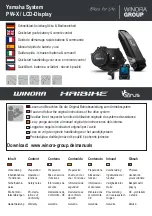
43
6.0 Maintenance
Your Trice has been built from quality materials and parts, and will last for many years with just a bit of simple
maintenance. Although there is nothing on the trike that a bike shop can’t maintain for you, doing your own
basic maintenance gives you a good feel of how your trike is working.
6.1 Lubrication
TIP - as with any cycle, a small amount of regular care will prolong the life
of your trike and its components. The simplest thing you can do is to
regularly give a quick drop of oil to all of the moving parts especially after
riding in heavy rain. Always keep the chain and chain tubes oiled.
Lubricating the Chain
At regular intervals, and always after riding in wet weather, you should lubricate the chain. The chain tubes
supplied with your Trice will help keep the oil on the chain by protecting it from rain and dirt, prolonging chain
life. Check with your local bike shop to see which chain lube works best in your area. It is not necessary to use
a lot of lube on the chain; better to use a little every week than a lot once a month. Wiping the chain down
occasionally with a dry cloth will help keep it clean and prolong its life.
Other lubrication
Rear hub, head set and pedal bearings on your trike will need greasing from time to time depending on riding
conditions, the same as any conventional cycle. The plain bearings in the suspension pivot need no lubrication. If
they show any significant wear (unlikely), they are simply pushed out and replaced with new ones.
The steering ball joints don’t require lubrication.
The front hub bearings, handlebar (stem) bearings, and pulley bearings are pre-lubricated and sealed. If they
feel rough or sloppy, they should be replaced.
6.2 Adjusting cables
Cables don’t normally need a lot of adjustment. When they are new, they will stretch slightly, and that stretch
needs to be adjusted out of the system. Check all cables regularly for signs of damage.
Brake Cables
To adjust the brake cables, loosen the locking nut on the barrel adjuster (this is the part that hooks into the
brake backing plate on the inside of the hub). Screw the barrel adjuster out a little and check the brakes. When
squeezing the lever, it shouldn’t come too close to touching the handlebar grips. When the lever is released, the
wheel should turn freely and not drag on the brakes. When the cable is adjusted, tighten the locking nut. If you
are out riding and feel the cable could be a bit tighter, you can turn the adjuster on the brake levers to fine-tune
the cable tension.
Derailleur Cables
These are adjusted in the same way as brake cables. There is an adjuster on the rear derailleur, but none on the
front. For the front derailleur, it is only necessary to have the cable tensioned slightly when the chain is on the
inside chainring; fine tuning can be done using the adjuster on the left-hand shifter.
6.3 Drum Brakes
The drum brakes on your trike have a very long life, and shouldn’t ever need replacing under normal use. We
have yet to see a worn out set of pads. If you find that the brakes are not gripping as well as they used to, they
can be disassembled and de-glazed. Remove the wheel from the bike, and then the backing plate from the
wheel. Note how the spacer between the hub and the backing plate is located. If the pads are glazed, they will
look somewhat shiny and smooth. Using some fine sandpaper, lightly sand the surface of the brake pads until
they look dull again. Be careful about not breathing in the dust from the surface of the pads. Clean the inside of
the hubs out with a clean, dry cloth (use no oil, grease, or wax on the inside of the hubs), then reassemble the
brake plates on the hubs. You should notice a difference in braking performance, and you should initially test
them away from traffic until you are used to the improvement in braking. If you notice a gradual reduction in
braking power over a period of time, check the condition of the brake cables and housing. Friction from dirty
cables can considerably increase the effort required to stop the trike.
TIP – periodic removal and lubrication of the brake cables helps increase
their life and gives smoother operating brakes. Disconnect them at the
wheel, and then a small amount of light oil can be dribbled down the
housing without removing the inner cable.
Summary of Contents for 2009 Trice Q
Page 4: ...4 1 2 Overview...











































